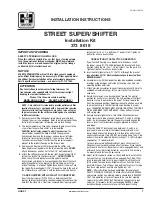
WARNING!
ments. Remove the child restraint before adjusting
the vehicle seat position. When the vehicle seat
has been adjusted, reinstall the child restraint.
•
When your child restraint is not in use, secure it in
the vehicle with the seat belt or LATCH anchor-
ages, or remove it from the vehicle. Do not leave it
loose in the vehicle. In a sudden stop or accident,
it could strike the occupants or seatbacks and
cause serious personal injury.
Children Too Large For Booster Seats
Children who are large enough to wear the shoulder
belt comfortably, and whose legs are long enough to
bend over the front of the seat when their back is
against the seatback, should use the seat belt in a rear
seat. Use this simple 5-step test to decide whether the
child can use the vehicle’s seat belt alone:
1. Can the child sit all the way back against the back of
the vehicle seat?
2. Do the child’s knees bend comfortably over the front
of the vehicle seat – while the child is still sitting all
the way back?
3. Does the shoulder belt cross the child’s shoulder
between the neck and arm?
4. Is the lap part of the belt as low as possible, touch-
ing the child’s thighs and not the stomach?
5. Can the child stay seated like this for the whole trip?
If the answer to any of these questions was “no,” then
the child still needs to use a booster seat in this
vehicle. If the child is using the lap/shoulder belt, check
seat belt fit periodically and make sure the seat belt
buckle is latched. A child’s squirming or slouching can
move the belt out of position. If the shoulder belt con-
tacts the face or neck, move the child closer to the cen-
ter of the vehicle, or use a booster seat to position the
seat belt on the child correctly.
WARNING!
Never allow a child to put the shoulder belt under an
arm or behind their back. In a crash, the shoulder
belt will not protect a child properly, which may result
in serious injury or death. A child must always wear
both the lap and shoulder portions of the seat belt
correctly.
Recommendations For Attaching Child Restraints
Restraint Type
Combined Weight of the
Child + Child Restraint
Use Any Attachment Method Shown With An “X” Below
LATCH – Lower Anchors
Only
Seat Belt Only
LATCH – Lower Anchors
+ Top Tether Anchor
Seat Belt + Top Tether
Anchor
Rear-Facing Child Restraint
Up to 65 lbs (29.5 kg)
X
X
Rear-Facing Child Restraint
More than 65 lbs (29.5 kg)
X
Forward-Facing Child
Restraint
Up to 65 lbs (29.5 kg)
X
X
Forward-Facing Child
Restraint
More than 65 lbs (29.5 kg)
X
146
SAFETY
















































